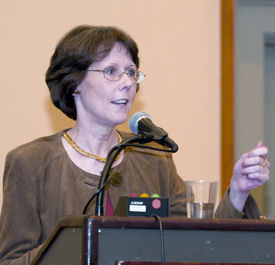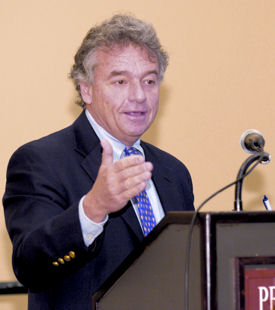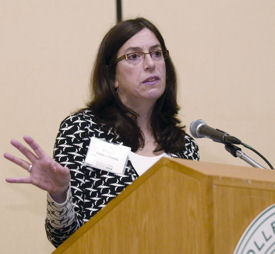Dermatology lessons learned, warts and all
A crowded and popular scientific session at Internal Medicine 2009 outlines the essentials of psoriasis, eczema, acne, rosacea and warts.
The attendees leaned against walls, sat on the floor and raised the room temperature several degrees, all so they could learn more about scaly patches and engorged pustules before lunchtime.
Speaker Julia Nunley, ACP Member, professor and dermatology program director at Virginia Commonwealth University, was happy to oblige all comers to “Essential Dermatology for the Practicing Internist” at Internal Medicine 2009. She focused on the most common skin conditions one encounters in the office, including psoriasis, eczema, acne, rosacea and warts.
Treating psoriasis

Psoriasis affects 2% of the population, “and that's quite a lot,” Dr. Nunley noted. Its characteristic red, scaly patches most commonly appear on the scalp, extensor surfaces (elbows, knees) and gluteal cleft though not always.
“In less common cases, psoriasis can be limited to the palms and the soles of the feet. I send these particular patients to their human resources representative or disability office, because they will be disabled until the problem is fixed,” Dr. Nunley said. “Imagine trying to see patients when your hands are covered [in plaques].”
Psoriasis runs in families and is vulnerable to triggers. Factors that can cause flare-ups include recent, concurrent or occult infection such as strep throat; alcohol consumption; stress; and certain medications such as NSAIDs, beta-blockers and hydroxychloroquine.
“You can still use these medications in patients with psoriasis, but know that that they may cause a flare-up,” she said.
Treatment for psoriasis is dictated by where the plaques occur, the percentage of body surface area involved and the presence or absence of arthritis. Treatment options include topical steroids or systemic therapy along with topical steroids, but usually not systemic therapy alone, Dr. Nunley said.
“Systemic steroids should be avoided, unless they are absolutely indicated for other reasons,” as they may cause flares, she said. “If you use them, taper slowly—like over one month—and monitor carefully because of the risk of pustular psoriasis.”
Systemic therapy is generally reserved for severe and/or disabling disease, “not your scaly patches on the elbow or knee,” she said. Phototherapy, such as broadband and narrow band UVB, and retinoids such as acitretin may be preferable to biologic immune modulators, which are expensive.
“Use biologics as your third line of treatment or with a patient who has arthritis,” Dr. Nunley said.
For all other patients, physicians should choose the class of corticosteroid they prescribe based on the severity of the patient's condition. More potent steroids should be used for thicker lesions, but Class 1-4 steroids should be avoided on the face and flexural areas, Dr. Nunley said.
Patients can also use emollients and over-the-counter keratolytics as treatments, she said. These include tar, salicylic acid, urea and lactic acid, which can be bought over the counter, and retinoids such as tazarotene (Tazorac). Triamcinolone (TAC) is also effective and comes in 1-pound jars for about $15, Dr. Nunley said, compared to about $75 for a 60-gram tube of Class 1 steroid. Natural sunlight works and is obviously cheap, although it carries an increased risk of skin cancer, she said.
Patients with psoriasis are at higher risk of heart attack, and thus need to be monitored for abnormal lipid levels and hypertension, Dr. Nunley said. Many may also suffer from joint stiffness, especially in the morning, so doctors should always ask about it.
“A patient can have psoriatic arthritis even if he or she has only one plaque,” Dr. Nunley said. “If so, he or she may need immune modulation and a disease-altering medication.”
Explaining eczema
Eczema is a “garbage bag term” for inflammation of the epidermis, and comes in a wide variety of presentations, Dr. Nunley said. Acute eczema is red, weeping, blistery and oozy, while chronic eczema is dry, scaly, thickened and cracked. The latter may also be hyperpigmented or depigmented, depending on a patient's skin color, or how much she or he has scratched.
Eczema often appears on the hands, legs and arms, or the site of exposure to an allergen, she said. The condition can be either intrinsic, the result of a genetic manifestation, or extrinsic, from exposure to an irritant or allergen.
“If you stuck your hand in a vat of [bleach] for a week, you'd probably get extrinsic eczema,” Dr. Nunley said.
Therapy for eczema follows this general rule of thumb: “If it's wet, dry it; if it's dry, wet it.” Drying agents include tap water, aluminum acetate and lotions; wetting agents include ointments and creams (and not lotions, which are mostly made of water). If these don't work, corticosteroids and immune modulators may be used, but systemic therapy is rarely necessary, Dr. Nunley said.
Corticosteroids come in seven classes ranging in potency, with Class 1 being the most potent. Physicians should learn the name of at least one corticosteroid per class, Dr. Nunley said. She recommended:
Class 1: clobetasol propionate
Class 2: fluocinonide
Class 3: betamethasone dipropionate
Class 4: triamcinolone acetonide
Class 5: hydrocortisone valerate
Class 7: hydrocortisone (OTC)
Patients can help to self-manage their condition by taking short showers in warm (not hot) water, and using moisturizing soaps. Baths are acceptable, as long as the patient uses bath oil (not baby oil) in the water. Handwashing should be kept to a minimum, Dr. Nunley said.
In addition, creams and ointments should always be used within three minutes of finishing a bath or shower, since water is a drying agent and will start desiccating the skin right away, she said.
Finally, when treating patients with eczema, it's important to be empathetic, Dr. Nunley said.
“Eczema waxes and wanes. What the patient wants is a cure, but there is none,” Dr. Nunley said. “They need to know it's a chronic condition, but that you will help them manage it.”
Acne advice
Patients with acne vulgaris turn up all the time, and lately, there are more cases than ever in the adult population, Dr. Nunley said. The first step in diagnosis is to look at the primary lesions and verify that the patient really has acne and not another skin disorder or condition, she said. In women, for example, it's important to ask about the menstrual cycle, especially if the patient is hirsute.
“You don't want to miss polycystic ovarian syndrome,” Dr. Nunley said. “I usually tuck my finger under a woman's chin when I'm examining to see if she's shaving, since some women will not tell you this.”
Acne with hirsutism is especially tough to treat, she added.
“I throw everything at it—keratolytics, antibiotics and anti-inflammatories,” Dr. Nunley said. “I try to encourage a better form of hair removal, because if you can get the hair to go away, the rash will probably go away, too.”
Physicians should also ask patients, particularly older patients, whether they have flushing or blushing, in case the condition is related to rosacea. In addition, if the patient has dandruff or truncal involvement, it's probably not acne but pityrosporum folliculitis, she said.
The next step in diagnosis is to determine if the acne bumps are comedones (blackheads) or inflammatory nodules/cysts or pustules. Retinoids are typically prescribed as treatment for comedones, while nodules and cysts usually need oral antibiotics, or isotretinoin when antibiotics don't work. Dr. Nunley said. Inflammatory papules/pustules often require an oral or topical antibiotic, a drying/keratolytic agent or an antifungal, she said.
The most commonly prescribed retinoid for comedones is adapalene (Differin), which is especially useful in those with drier skin. Tretinoin (Retin-A) is also popular, while tazarotene (Tazorac) is sometimes poorly tolerated. Antibiotics clindamycin (Cleocin), erythromycin, and sodium sulfacetamide with sulfur are often used for nodules and cysts, with a topical retinoid added on later when the skin is less inflamed.
“Sodium sulfacetamide with sulfur is my personal favorite medicine to use, though be aware that it can be drying when used as a wash,” Dr. Nunley said.
Patients who get what appears to be acne on their backs are actually more likely to have pityrosporum folliculitis, a condition where yeast affects the hair follicles. As such, it's best treated with anti-yeast washes like benzoyl peroxide, pyrithione zinc and selenium sulfide, and topical anti-yeasts like ketoconazole, terbinafine and benzoyl peroxide, she said.
One final, important aspect of therapy is ensuring that patients know their acne will take time to clear up, Dr. Nunley said. Medications can take two to three months to work, and even then, the condition may only lessen instead of disappearing completely.
“The patient wants 100% of those lesions reduced, not 80%,” Dr. Nunley said. “Many will wait three weeks, and if it's not cleared up, they will quit therapy.”
Tips on rosacea
Rosacea is marked by an unusual increase in vascular reactivity, and can present as flushing and blushing; a fixed redness, usually in the cheeks; inflammatory papules; telangiectasias; and rhinophyma (in men only). The condition often flairs with menses, Dr. Nunley said.
“There are different flairs for different patients. In my case, I flair when I fly,” said Dr. Nunley. She recommended a Web site as a good source of information about flair factors.
Most often striking those with a rosy-cheeked complexion, rosacea is a condition that a person is born with and that worsens with age and sun exposure. The most important treatment is sun protection, followed by topical or oral antibiotics like metronidazole, clindamycin and erythromycin. Other options include sodium sulfacetamide plus sulfur, and azelaic acid, Dr. Nunley said.
Unfortunately, there isn't much that can be done for the patient with rhinophyma, she added. If topicals, oral antibiotics and isotretinoin don't work, surgery is an option, though there is potential for permanent disfiguration of the nose.
Warts and all
The treatment for warts is extensive, and ranges from acids to cryosurgery to laser therapy. All of these are pretty much equally effective, Dr. Nunley said.
“When you see a list this long, you know none of it works all that well on its own,” she quipped, showing a slide with many different types of treatment.
Dr. Nunley is a “big believer” in cryosurgery for warts, as well as for certain other conditions like seborrheic keratoses, lentigos, dermatofibromas and molluscum contagiosum. The correct freeze times for cryosurgery are:
Verruca plana: 5 seconds
Verruca vulgaris: 15-20 seconds
Lentigo: 7 seconds
Actinic keratosis: 5-10 seconds
Molluscum contagiosum: 5-10 seconds
Seborrheic keratosis: 10 seconds
Dermatofibroma: 30 seconds
Paring the wart before freezing using an 86 blade/curette can be a good idea for “getting the nitrogen where you want it to go,” Dr. Nunley said. Cryosurgery should never be used for moles, and a doctor should never “double dip” when doing back-to-back cryosurgeries, as HPV can actually live in liquid nitrogen, she said.
After cryosurgery, the treated area will blister in about six to 24 hours, then scab and peel within 10-14 days. Freezing for too long will cause permanent scarring and depigmentation, especially in people of color, she said.
“It's better to under-freeze than over-freeze,” Dr. Nunley said. “You really have to know what you are doing if you are going to do cryosurgery on people's faces.”





